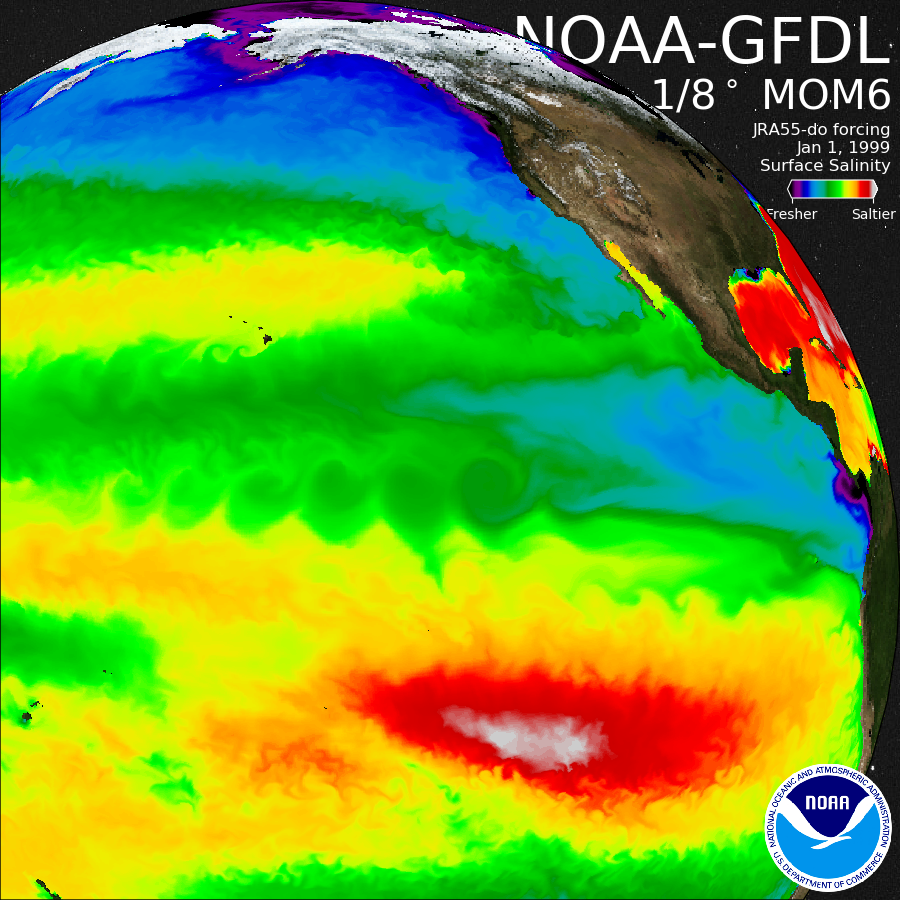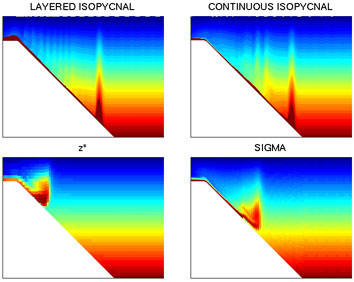Ocean Circulation Models
While ocean models start with the same continuous equations, the discrete equations possess important distinctions that play a role in the simulation features. In particular, different parts of the ocean are most naturally represented using different vertical coordinate systems. Level-coordinate models consider each box at the same level, with geopotential or pressure the common basis for defining levels. These models are relatively easy to code and have been the basis for ocean climate modeling since the 1960s. Such models may also have particular advantages in representing the transition between the poorly stratified mixed layer and the interior ocean where flow is predominantly along density surfaces. In contrast, isopycnal models handle the interior ocean more naturally, and may also have significant advantages in representing thin dense overflows. In shallow shelf regions, where the top and bottom boundary layers are thought to be most important, many oceanographers use terrain-following coordinate systems. For more discussion on matters of vertical coordinates and their use in the modeling community, see the review paper from Griffies et al., 2000.
Ocean Model Development at GFDL
GFDL has been developing ocean models since the late 1960’s starting with the Cox and Bryan ocean model and many present ocean models trace their origins to this code. Since the late 1980’s, GFDL has produced multiple versions of the Modular Ocean Model, known as MOM. All versions up to and including MOM5 used Eulerian vertical coordinates. In 2005, GFDL embarked on a complementary path to prototype a new generation of ocean model for the study of climate. The prototype used a Lagrangian vertical coordinate based on density layers rather than depth or pressure levels used in MOM5. This work produced the Generalized Ocean Layer Dynamics (GOLD) code. Being able to simulate the ocean climate system using two distinct and complementary ocean model classes is an exceptionally valuable capability, as exemplified in studies using GFDL’s ESM2M (level based using MOM5) and ESM2G (isopycnal based using GOLD) Earth System Models. You can read more about the history of GFDL ocean model development here.
Lessons learned from the comparison of ESM2M and ESM2G motivated a decision to develop MOM in a new direction. A new treatment of the vertical direction was clearly warranted and a unification of efforts needed. In December of 2012, the first GitHub commit was made for MOM6 which began a new era of development.
MOM6

MOM6 incorporates the Lagrangian vertical coordinate work (White et al., 2009) prototyped in GOLD, including a conservative representation of wetting and drying essential for evolving ice shelf grounding lines, along with key physical parameterizations and analysis features of MOM5. In contrast to MOM5, which uses the Arakawa B-grid, MOM6 uses an Arakawa C-grid which is more appropriate for mesoscale eddy-rich simulations. MOM6 also has a tracer sub-cycling time-stepping scheme that allows for an efficient incorporation of many bio-geochemical constituents. The Lagrangian treatment (Griffies et al., 2020) of the vertical supports a general coordinate capability including hybrid vertical coordinates. Hybrid coordinates have been shown to reduce spurious mixing in the ocean interior and permit a more faithful representation of overflows, both of which are important for studying ocean climate on centennial and longer time scales. MOM6 is the ocean code used in OM4 (Adcroft et al., 2019), the ice-ocean component of the latest GFDL coupled climate model, CM4 (Held et al., 2019), the earth system model, ESM4, as well as the seasonal-to-decadal prediction model, SPEAR. Additionally, MOM6 is part of the long-standing MOM community of codes and has adopted the open-development paradigm thus encouraging participation among government agencies and academic partners.
Earlier MOM configurations

The Modular Ocean Model (MOM) is the canonical large-scale ocean climate model used at GFDL and around the world. MOM4 formed the basis of the CM2.1, CM2M, ESM2M, and CM2.5 climate models used for high-end modeling that contributed to the IPCC AR4 and AR5 assessments. MOM5 is the most recent version of the Eulerian-algorithm code released in October 2012 (https://mom-ocean.github.io/).
GOLD configurations
The Generalized Ocean Layer Dynamics (GOLD) is a generalized Lagrangian-coordinate ocean code (Adcroft and Hallberg, 2006). GOLD can be configured using geopotential (z*), terrain-following (σ), layered isopycnal, or a continuous isopycnal (ρ) coordinate for describing the vertical (see, e.g., White et al., 2009 and the animation at right). Nonetheless, the principle use of GOLD has been as an isopycnal coordinate ocean climate model, following in the lineage of the Hallberg Isopycnal Model (HIM).
Quick links
MOM6 Contact: Email us
Technical reports
- History of GFDL ocean model development (pdf)
- MOM5 guide (~6Mb)
- MOM4 guide (~2Mb)
- MOM3 guide (~5Mb)
- MOM2 guide (~2Mb)
- MOM1 guide (~530kb)
- “Cox code” (~7Mb)
References
Adcroft, et al. 2019: The GFDL Global Ocean and Sea Ice Model OM4.0: Model Description and Simulation Features. Journal of Advances in Modeling Earth Systems, 11(10), DOI:10.1029/2019MS001726.
Griffies, Adcroft, and Hallberg, 2020: A Primer on the Vertical Lagrangian‐Remap Method in Ocean Models Based on Finite Volume Generalized Vertical Coordinates. Journal of Advances in Modeling Earth Systems, 12(10), DOI:10.1029/2019MS001954.
Held, et al. 2019: Structure and Performance of GFDL’s CM4.0 Climate Model. Journal of Advances in Modeling Earth Systems, 11(11), DOI:10.1029/2019MS001829.
White, Adcroft, and Hallberg, 2009: High-order regridding–remapping schemes for continuous isopycnal and generalized coordinates in ocean models. Journal of Computational Physics, 228(23), DOI:10.1016/j.jcp.2009.08.016.


